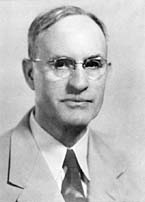Elias Howard Sellards (1875-1961)
 Dr. Elias Howard Sellards, Professor, Director Emeritus of the Bureau of Economic Geology, former Director of the Texas Memorial Museum, and distinguished geologist, died at the age of 85 in Austin, Texas, February 4, 1961.
Dr. Elias Howard Sellards, Professor, Director Emeritus of the Bureau of Economic Geology, former Director of the Texas Memorial Museum, and distinguished geologist, died at the age of 85 in Austin, Texas, February 4, 1961.
Dr. Sellards was born May 2, 1875, at Carter, Kentucky. The family moved to Kansas by covered wagon when Dr. Sellards was a youth. He attended school both at Carter, Kentucky, and Scranton, Kansas, completing his high school education at Scranton in 1894. He was a student at Washburn Academy at Topeka, Kansas, and then attended the University of Kansas at Lawrence and was graduated with the BA degree in 1899; he received the MA degree from that University in 1900. He continued graduate study from 1901 to 1903 at Yale University, holding both a scholarship and fellowship, and received the PhD degree in 1903. At Yale his work brought him under the influence of three famous teachers, Charles Schuchert, Charles E. Beecher, and H.S. Williams. Charles Schuchert became a close personal friend and visited Dr. Sellards many times in his home.
Dr. Sellards began his teaching career as Instructor in Geology and Mineralogy at Rutgers College, New Brunswick, New Jersey, during the 1903-1904 school year. He accepted the Chair of Professor of Geology and Zoology at the University of Florida, at Gainesville, in 1904 and continued in this position until 1907, when he became State Geologist of Florida and moved to Tallahassee. While he was Florida State Geologist, he published 12 annual reports, two bulletins, and numerous articles of enduring prominence. These publications related mainly to basic geology and mineral resources of Florida. During this period he devoted considerable attention to fossil vertebrates, especially early man, and was constantly on the alert for evidence of early man. In 1913, human remains were found in the undisturbed wall of a canal at Vero (now Vero Beach), Florida. This discovery resulted in a conference of noted scientists at the site in 1916.
Dr. Sellards moved to Texas in 1918 to accept the position of Geologist on the staff of the Bureau of Economic Geology offered by Dr. J. A. Udden, then Director. He was appointed Associate Director of the Bureau in 1925 and succeeded to the Directorship in 1932, which position he held until 1945 when he was placed on modified service. He was appointed Professor of Geology and a member of the Graduate Faculty at the University of Texas in 1926 and was Director of the Texas Memorial Museum, Austin, from 1938 until retirement in 1957. He was the Director Emeritus of the Bureau of Economic Geology from 1945 until his death, maintaining an office in J Hall on The Little Campus and entering into the activities of the Bureau as his physical condition permitted.
During his 39 years of service at UT-Austin, Dr. Sellards attacked geological and paleontological problems with insatiable interest. One of his first assignments, placed on him by the Attorney General of Texas, was to determine the original boundary between Oklahoma and Texas along the Red River. He presented his work so thoroughly that the Supreme Court of the United States rendered an opinion favorable to Texas.
Between never-ending administrative duties, he found time to author and edit extensive reports on the geology and mineral resources of Texas. Among the important contributions are the two-volume compendium on the stratigraphy and structure of Texas, with accompanying geologic and structural maps of the State, and a book on “Early Man in America” including bibliography of literature on the subject. He was engaged on extensive revision of this book at the time of his death. During W.P.A. days, Dr. Sellards directed a paleontological project which assembled an outstanding collection of Pleistocene fossils remains. He taught stratigraphy in the Department of Geology and supervised 17 Master’s students and one PhD student.
Dr. Sellards participated in University affairs by serving on the Sharp-Cullinan Scholarship Committee. He was largely responsible for initiating the Petroleum Engineering Department of the University.
The University of Kansas presented the Erasmus Haworth Award for a distinguished alumnus in 1958 to him at an alumni luncheon in Los Angeles and the University of Florida has established the Sellards’ Geology Student Award in his honor because of his contributions to basic geology in that state.